Limping His Way to Success
By Yusimí Rodríguez

HAVANA TIMES, Nov. 7 — Mercedes Aguirre, my famous model friend, told me about Alfredo when she found out that I was “hunting” for interesting characters to interview.
She described him as a hairdresser who was missing a leg and who lived in a small room with a barbacoa (an improvised second level) on an upper floor of a building in the Centro Havana neighborhood.
I was thinking that a story like that might be rather depressing for readers, but nevertheless I decided go to go ahead and meet him a couple of weeks ago.
The man wasn’t at home when I dropped by, which I thought was strange after counting the number of steps he would have to climb to get to his room, combined with the fact that he was physically disabled. “Don’t be surprised, he gets around Havana on a bike,” Mercedes told me over the phone when I called to let her know that my first visit hadn’t panned out.
At that moment I knew that neither I nor the readers were going to suffer from the story of this man, who to my surprise I had actually met fifteen years earlier. He had been a model, a designer and a maker of sweets, but now he was a hairdresser who had succeeded in creating a new hair product.
Different from other interviewees, Alfredo is a person who will tell you about himself almost without needing to be asked questions.
“I’m Alfredo Nuñez Elias. I was born on January 26, 1960; so I’m fifty years old.
In my childhood I always had a talent for carpentry and woodwork. Later I got into sewing and into what I had already learned about making sweets; I had been taught that by the woman who raised me – someone who I owe a great part of my the talent that I have today. Now, at 55, I’m trying to become someone good for my country and, if possible, good for the world.
I always tried to do things with perfection, be it making a skateboard or a scooter. They may have been built by a poor child, but with much dignity. We were instilled with the belief that studying was something very fundamental; this was in the 1960s, when studying was very important for any person from a poor family.
By the 1980s I had decided to go into sewing to show myself that even though I was poor, I could still dress well. It was also so that people could see that it wasn’t necessary to buy name brand clothes —like Christian Dior for example, which were in fact beautiful, even glamorous— but that with talent, we could create those similar things. In this way I taught myself to be an artful tailor, always looking for perfection in the curves, in the cuts, in the design.
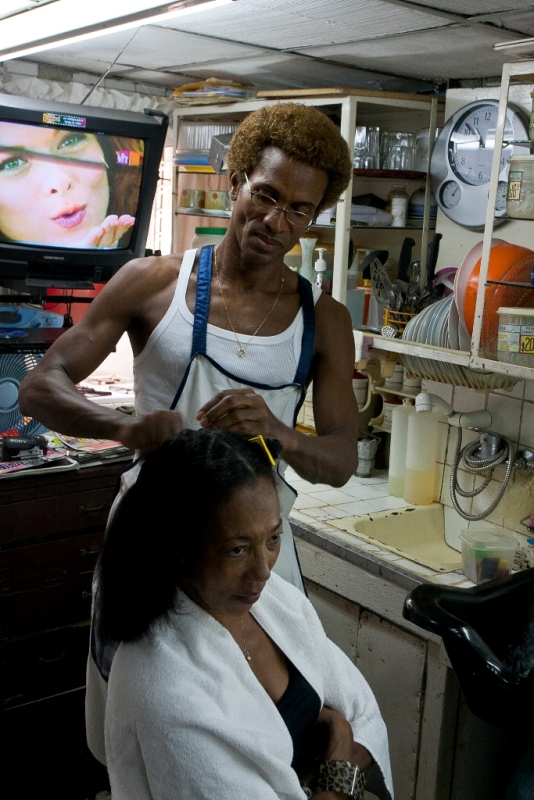
This led me to start presenting my designs. These were in style in the ‘80s, even though they were created by this unknown and empirical designer. I believe that we Cubans are always trying to demonstrate something, and I wanted to see how far I could go with these. This was my thinking when I put on my first fashion show in 1986 as part of a peña hosted by singer Hector Lopez. Everything that related to the show was stunning —with the models behind stage, the changing of clothes and everything— so I allowed myself to revel in my pride and I began putting on other fashion shows.
HT: However yesterday you told me that you yourself were a model, and that the famous model Norka Mendez discovered you. Can you tell me about that?
ANE: Yeah, Norka is really someone who I admire a lot. It was in 1981 when I went to the offices of a magazine where they were looking for models and where they also conducted studies aimed at upholding the culture of dressing. I met Norka there and was struck by the fact that she didn’t have any guys with my type of skin in her group.
She began to prep us, and it was very interesting; she explained how the models in her house had to be…the kinds of attitudes they needed to have. That taught me that when walking out onto the runway it wasn’t enough to have a pretty face; you also needed a beautiful spirit. That was what Norka taught me.
But I avoided something that I should have said from the beginning. I was born with a congenital circulatory malformation: Klippel Trenaunay Syndrome. So when I was around ten, back in the 70s, I began to suffer from these varicose ulcers, inflammations in my legs from the promontories in my veins. All this was complicating my being able to get around, though it never frightened me.
In 1976 they told me that it could lead to amputation if I didn’t take care of my legs. So when I met Norka I was already suffering from this malformation, but it didn’t bother her. She centered on the model’s image and on their spiritual aspects. What she was trying to achieve was the development of an integral model.
In any case, I knew I wasn’t going to go far as a model, so I choose to tap into my potential as a designer so as to remain in this world of fashion that I loved so much. At twenty-six I decided to do that, and this was when I began to design and sew my own fashions. I devoted myself to everything that involved sewing, and with tremendous passion. My first fashion shows were lovely, which is why I received people’s applause, respect and everything that gives one the force to carry on.
HT: I remember that I met you in 1995, at an event called “The Unknown Designer” in Pabellon Cuba. By that time you had already lost your leg.
ANE: At that time I’d been without my leg for two years, which is to say that it was amputated in 1993 – in the middle of Special Period economic crisis, when everything was becoming aggravated in our country. Medicine was scarce and things were generally difficult, to say the least. I have to always emphasize that my life was very basic. The condition of my leg suffered a total decline, to the point of showing signs of gangrene in one toe. That was dangerous because it could have reached the stage of gaseous gangrene and killed me.
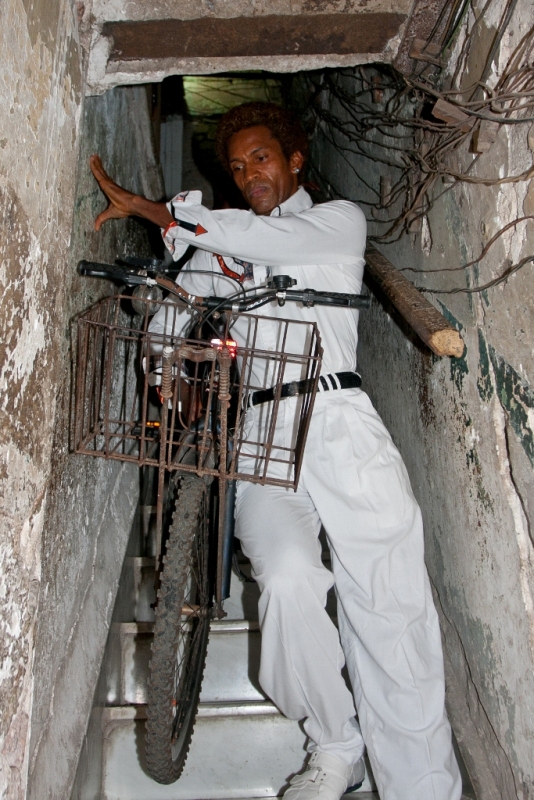
When they amputated my leg, I thought everything was over, having lived in this glamour world of fashion. It was terrible that I was missing a leg. For many people it was an effort to even say hi to me; they would turn their heads and look away. Maybe it was out of fear of hurting my vanity as a model, but what they didn’t know was that I was prepared for this, because my life didn’t depend on that leg but on my the possibilities for creating, and those remained intact in my mind, in my hands and in my heart. They’re what I build on day after day, and they give me aspirations and dreams. I dream of that world every day.
Still I had to look for strategies to make it, and that wasn’t easy for me. Then too, I didn’t even have crutches. I had to come up with a makeshift crutch as well as a cane. I went limping around on that crutch for those first days, making it as far as Infanta St., and from there I could catch a bus to the La Cobadonga Hospital. They had warned me that things wouldn’t be the same, and that there would be many setbacks that I’d have to overcome.
I didn’t believe it, but it was really terrible to try to climb up into a bus. Though there were seats for people who were physically handicapped, there were people who didn’t want to give up theirs up to a handicapped person or to anyone else. They would tell me, “I’m handicapped too.” It was rough. It was the first time that I’d caught a bus as a handicapped person and I was denied the right to a seat. It brought me to tears, but it made me stronger. I realized that I would have to use my willpower to make it to where I was going, where they were going to take out the stitches that were still left in after the operation, and then make it back home.
To me it looked like I’d never be able to organize another fashion show, but one day I sat down in front of the sewing machine and I asked myself: “If I know how to do so many things, why I don’t I continue doing them?”
I began to look through magazines that I had at that time and I began to make dresses. I made a collection of twelve fabulous dresses, and I got in contact with the Centro Havana Cultural Center to search for models who could wear my clothes. Many of the models that I had worked with in 1986 showed up when they found out I had “renewed my vows” as a designer. I once again began to put on fashion shows in places like the Marina Hemingway Yacht Club, beach resorts in Playas del Este and hotels in the upscale Miramar area. This went on through 1995, when you and I met at the Pavilion Cuba at the “Unknown Designer” show.
I also tried to expand my “Havanamodas” operation, but I didn’t get a chance. You have to remember that I’ve always lived a modest life; it’s as if something hasn’t allowed me to make the great leap forward.”
HT: So you lacked the resources?
ANE: Evidently. I remember that the ‘90s were the most critical years we went through. As for me, in addition to the consequences of the amputation, I could no longer dedicate myself to sewing for fashion shows to support myself economically. It was a time in which I did all kinds of work. In fact, I lost my leg because I didn’t have enough food to eat properly. I’ll have to save that part of my life for another moment though.
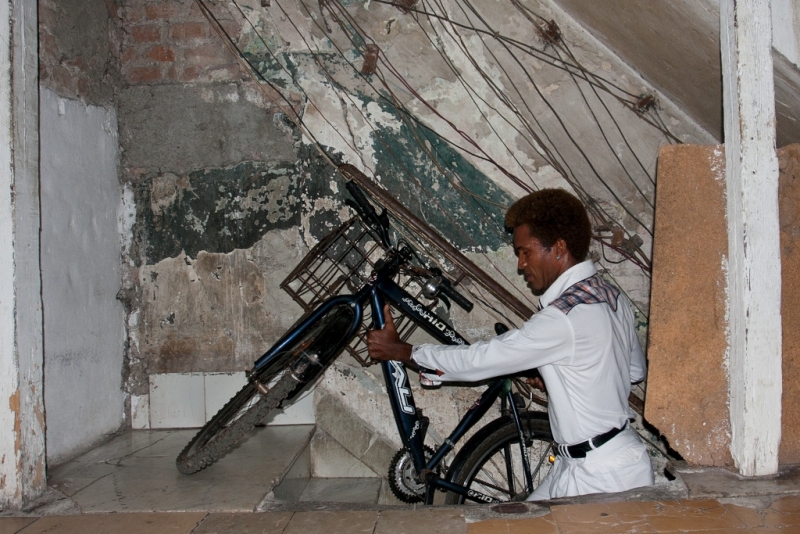
This was when I definitively had to look for other resources. Ever since I was nine or ten I had cut my father’s hair, as well as other people’s – both men and women. Then too, when I was between 16 and 25 I had friends who would straighten their hair. It always interested me in how we, as black people, would take our frizzy, unruly and hard to manage hair and make it easier to comb, easier to style and shinier. By the end of 1995 I decided to work in a hairdresser’s salon because I no longer had any money, nor could I depend on my sewing machine because no one was making clothes.
HT: So doing hair began a means of subsistence?
ANE: Yes, right, just like with tailoring, although I liked sewing and in fact I tried to take part in the fashion shows myself, but it was all cut short by the Special Period. You have to remember that used clothes started to be sold and this didn’t allow tailors and dressmakers to continue making their living off sewing.
So, it turned out that a famous hairdresser, Martica, who always gave her best, allowed me to work with her. It was special when I first met her; she first asked me what I knew how to do, and I told her: “What do you want me to do?” She ended up letting me wash and dry people’s hair, as well as curl and comb hair into style. She liked what I did a lot and at the end of the day said: “Well, are you working with me tomorrow?”
HT: How did you manage to work in a hairdressing salon with just one leg?
ANE: Well, you really need those two points of support, so I would place my stump on one of my crutches, and with the support of the other leg I was able to keep my balance while taking care of people’s hair. I also think that the fact that I’ve always done exercises helped.
Like I told you, Martica was a hairdresser who was very determined, but sometimes she didn’t have the supplies to take care of all her customers. One day I decided to ask her if she would sell me her formula for straightening hair, which was excellent, but she told me that she couldn’t. So I continued insisting and I asked her “Well, do you think I can sell that product?” But she told me that I couldn’t do that either.
I asked her to at least let me help her because sometimes she was tired and would have to tell the customers to come back the next day. But she lashed back saying, “Just leave me alone.” You see how far the love for one’s job can go? She wouldn’t even let me use her product, though she knew my ability as a stylist, and I had already sworn myself willing to do whatever she did. But she still wouldn’t let me.
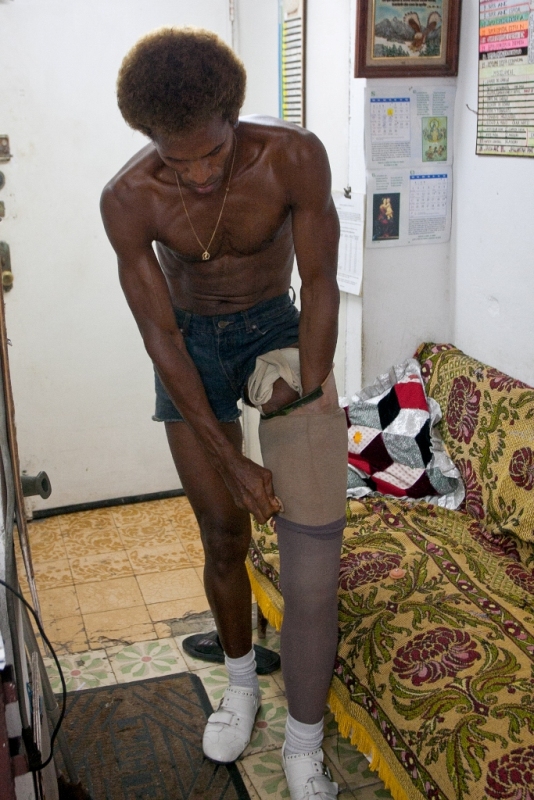
So then, as I always look to God in good times as well as in bad, I asked him to soften her little heart and to give me a chance make a formula similar to hers so that I could continue trying to make ends meet, because in this life you really have to constantly defend yourself with tooth and nail for subsistence. So she began to prepare that product in front of me and I remembered what she did. When she had determined that I knew what to do, one day she told me, “Alfredo, you’re done working for me.”
But I give thanks to God because I was able to observe something that later transcended me. Here at home I said to myself, “My God, I’ve been able to survive these months,” having to claw my way to survive, but I still didn’t have my prosthesis. I remember that in that event at Pavilion Cuba I went out on the runway with my crutches, but it was nice because people not only applauded my designs but also this physically handicapped person who came out onto the gangplank. When I stopped working with Martica I went home and began to try to make something close to what I had seen her make. I began by quickly buying things and mixing them up in measured quantities. I ended up with a stable formula that allows one to soften frizzy hair, remove the volume of wavy hair or to give body to straight hair. I realized that I had achieved something new.
HT: Did you know anything about chemistry in doing all this?
ANE: The chemistry you get in school, nothing more. Everything I’ve done, I’ve done empirically. I’m not a graduate of design school either. What I graduated in back in 1976 was naval diesel machinery. I came out as a mid-level technician in ‘76. But that helped me a lot later on, because there we had to draw.
HT: How is your potassium-based formula for relaxing hair different from the straightening products that are now sold in stores?
ANE: The difference is that my product respects 50 percent of the “virgin hair.” We all have virgin hair that hasn’t been tinted or chemically treaty, like yours is right now. If you decide to soften your hair, you’ll have to begin adding chemicals. But if this respects that 50 percent of the virgin hair, that’s good; if you go past that point you’ll begin to damage it. In November 1996 I achieved a stable, well-formulated product, and it has wound up becoming a novelty.
I already have a patent for this product, thanks to God, and today am trying to get it picked up by some industry for mass production. The creams go from line A, for straightening; line N for waves, and the line E, for styling. Each line also has different possibilities. For example, within line A we have eight products for straightening according to the thickness of the hair – from very fine hair to the thickest. This means we have achieved these lines and ranges of products so that anyone can decide to change their hair to make themself more attractive.
HT: Alfredo, do you think the sole alternative for black people’s hair is to soften it with chemical products?
ANE: No, absolutely not. The issue of black people’s frizzy and unruly hair is something accepted as a condition or avoided out of complacency. If we’re convinced that black skin means unruly and difficult to manage hair, then it’s because that’s what God gave us, just as he gave people with mestizo skin very thick and full bodied hair, and those with white or Asian skin limp straight hair.
According to one’s type of hair, each person will wear it or change it according to the technologies available. You can choose. But there must be products that can be used so that you feel comfortable, satisfied and attractive. You can accept that or not.

In the case of those of us with black skin who have unruly and unmanageable hair, this can be tamed with a product that modifies it and transforms it into wavy, frizzy or straight hair. If it’s your taste, you can continue using them, though undoubtedly they take their toll. But those tolls determine beauty, attractiveness and glamour from one point of view, though you can also be attractive with unruly and frizzy hair. This has been demonstrated. In this sense, beauty is determined by oneself.
HT: So do you have some product for people who wear their hair “virgin,” without it being straightened through any chemical treatment?
ANE: Of course! In fact it’s necessary. Those of us with frizzy hair need grease to keep it nurtured and soft, so that its natural texture is maintained, but at the same time to make it easier to comb. This involves adding some nutritious elements to it, not chemical ones that change the texture. So for this we’ve created a grease that can be used in hair that is 100 percent virgin.
HT: What do you think of straightening the hair of little girls?
ANE: We have a product for adults and a product for girls. The one for girls is not so aggressive, but even still we have one that is in a lower range compared to the one for adults, but it also fulfills its function of modifying the hair.
HT: What do you have in your hair? Is that your virgin hair?
ANE: This is a treatment to soften my hair. It’s a cream from the N line. It respects the texture of my hair, giving it an almost natural appearance. But it also softens it and allows me to apply another product that lightens my hair.
Mercedes Aguirre is one of Alfredo’s more recent clients, though she’s known him for many years. She gave me her opinion about both him and the product he had created:
“For me it was very hard at the beginning to accept that he lost a leg, because I knew him when he had two, and I always felt that he didn’t deserve such a bad break. I didn’t let him see it when he came to see me, but later I was left standing there crying.
“He spent a lot of time trying to convince me to let him straighten my hair, telling me how good the product was and saying that it would even make my hair grow. I told him to keep his feet on the ground and to stop dreaming. But in March I decided to drop by and I told myself: Well, the worst thing that can happen is that my hair will fall out, like what has happened with other products I’ve used.

“So I took the risk. I was very pleased. In fact, my coming here a second time is a demonstration of this, and it allows me to tell you that the product really does make hair grow. I didn’t want to believe it, because I’d never been able to make my hair grow using anything. I’m like Saint Thomas – I have to see it to believe it. But this product does in fact make your hair grow.”
Alfredo says that he succeeded in coming up with a successful product thanks to his clients, who are very sophisticated and demanding women.
HT: Alfredo, a little while ago I saw that you have two prostheses. Are they easy to get? How was the process of adaptation?
ANE: It’s not so easy for a person who is physically disabled to go and get themselves a prosthesis…to get the measurements taken and everything. Those things require a certain amount of will and limitless effort. There comes a moment when you’re about to give up, and that’s terrible because two support points are really necessary in order to walk.
You really do have the option of the going to have a prosthesis made, but the problem is that when they’re not lacking one thing they’re missing a screw. I’ve had to look for things that weren’t available to have my prosthesis made, for example plaster for making the molds, or pigment. I’ve had to wait for the chance to get the right shoe size, but those things take time, and they begin to shrink your dreams and illusions… I’m a person who needs to be a hairdresser, or a tailor.
To have my prosthesis made, I went to the Frank Pais Hospital one time – on one leg and by bicycle, because the transportation system was also terrible. I’m talking about 1995 or 96. I struggled to get two prostheses because I realized that sometimes I would want to change my footwear to ones that were lower, and that to do this with one prosthesis I’d have to adjust it, which can be quite complicated. That’s why now I have one for each type of footwear. Also, my adaptation wasn’t easy; the time depends on the degree of willpower a person has.
I’ve always done exercises and that in a certain way has helped me, but it took me five years to adapt. My stump is small and besides it’s full of varicose veins due to my illness. In the beginning it was very inflamed and it was necessary to wait for the inflammation to go down. I began the adaptation in 1994. It was very difficult and at times I was in despair and once I even threw the prosthesis on the ground because it seemed I was never going to adapt. In fact, when you met me, in 1995, I was on crutches without prosthesis. By the end of 1999 or the beginning of 2000 was when I could finally walk well with it.
HT: The other day you told me that you also make sweets, something that you learned from your “mother,” or the woman who raised you…
ANE: Well, I began to make sweets after I stopped working with Martica, the hairdresser. I had gotten into hairdressing on my own, but to tell the truth I still wasn’t ready for that. To be able to devote myself to hairdressing I needed an economic base that would allow me to buy products and get involved in research. So I began to buy flour, eggs, flavors, fruits. I sold my candies for three pesos, and people liked them a lot. With the money I made I could buy the products necessary for my research and the development of this formula.
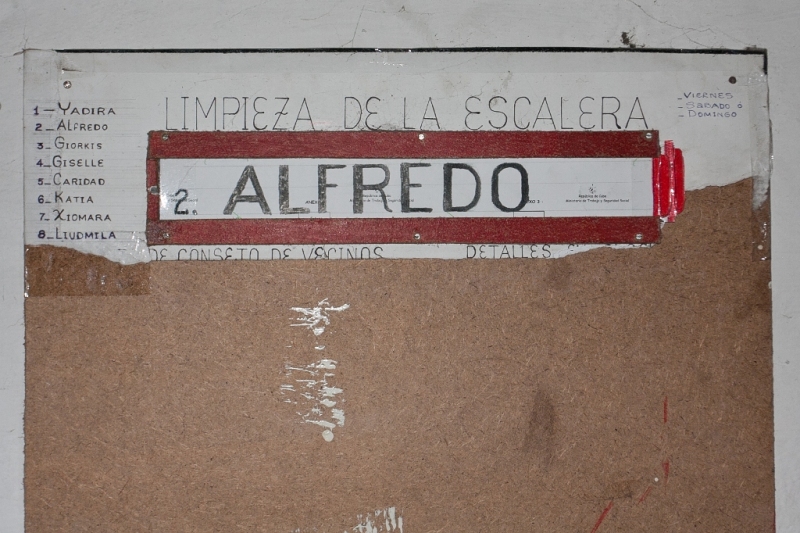
I’ve always loved making sweets. The woman who raised me, Esther Diaz Jimenez, used to fix them at home, and I always liked the idea of being able to bake a cake or a pie. Last year I received a certificate for baking sweets at the first International Culinary Festival in Santiago de Cuba. This was thanks to my teacher, Santiago Gasquet, who now comes on TV. I thank him for being aware of what it really means to make a cake or a pie or bread. When I met him I told him I wanted to be one of the best in his group, and I did really make an effort.
HT: Do you plan to get back into design any time?
ANE: That lies latent in my life daily. I need to be a designer, to return to the sewing machine, to see how my designs take on life up on the runway with the models. I can see that happening. In the meantime, I’m doing this work as a hairdresser, which is going really well and is going to help to lend a little to everything that might be needed.
HT: During our conversation you mentioned God several times. And when I came here the first time I saw that you had an evangelical message on the door. Do you practice the evangelical religion?
ANE: I am a believer in Jesus Christ, in God, above all things. I believe that God determines a mission for all beings in this world…in my case, for the good of humanity. I’m very grateful that God has allowed me to know Christ as the vehicle for these possibilities that I have today.
HT: You know that I can’t leave without knowing how you get on and off your bicycle. It doesn’t astonish me so much that you can ride it, because I’ve seen you. But getting on and off…?
ANE: Well, I use the stairway. I remember that when they amputated my leg they told me, “You’re going into a world where everything will be different for you, and you’ll have to overcome all of it.” I was ready for the challenge, and I learned that for me to overcome in this world, I needed only willpower and faith. My faith came from Jesus Christ, and the willpower was my own, something intrinsic in me. I say “I’m going to do this,” and I then I’m doing it. It’s the same way with getting on an off a bicycle – with faith and willpower.

Great story and one that resonates deeply with me. I was feeling sorry for myself until reading this wonderful
man’s faith and love of life and God. That has transformed him and perhaps a lesson for us all. Thanks!
Thank you, Yusimi, for allowing us to enter Alfredo’s world. I found this story inspirational. Sure, it satisfies my curiosity, but something more than that: it shows me that (a) everyone has potential (though few are able to go forward much in realizing it) and (b) when there is an irresistable urge to go towards the fruition of this potential, many obstacles can be overcome. This article almost made me weep, but not out of sentimentality, but rather out of joy at the ability of some individuals to overcome and triumph over adversity!